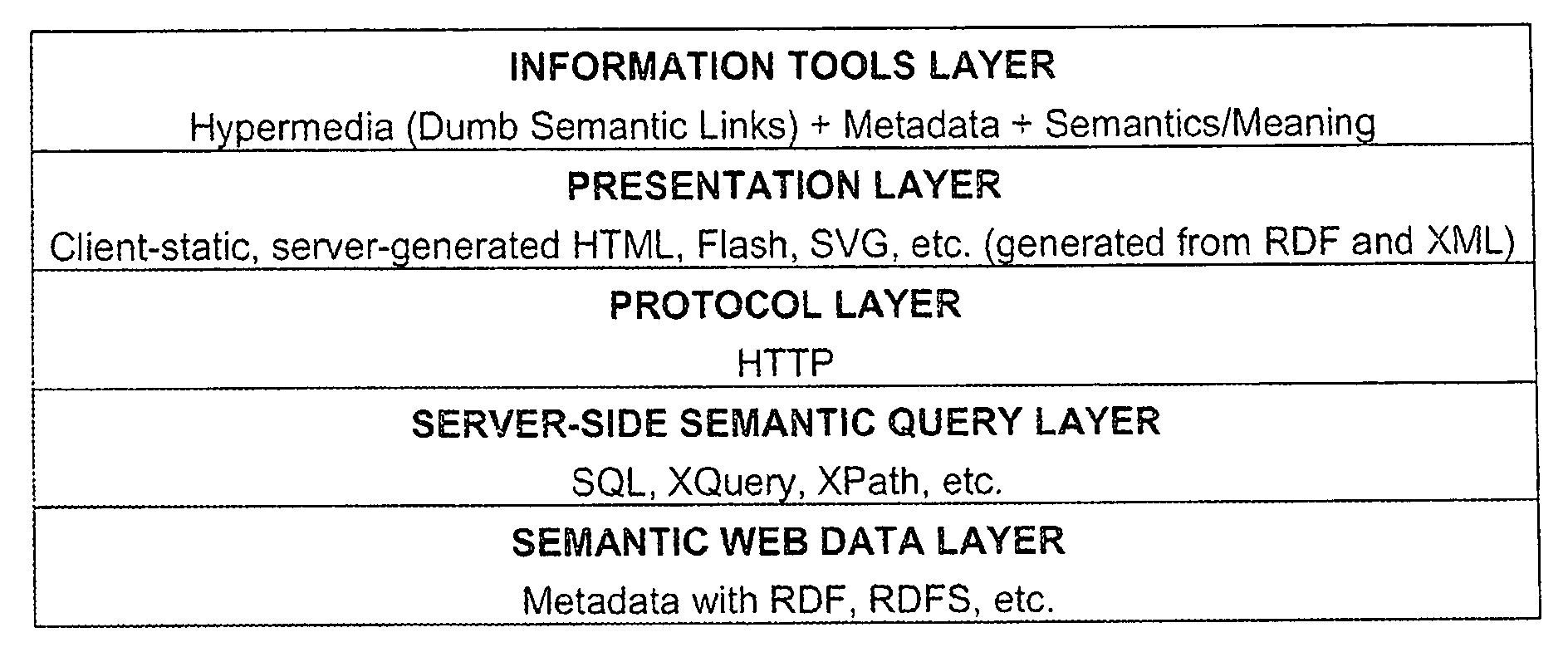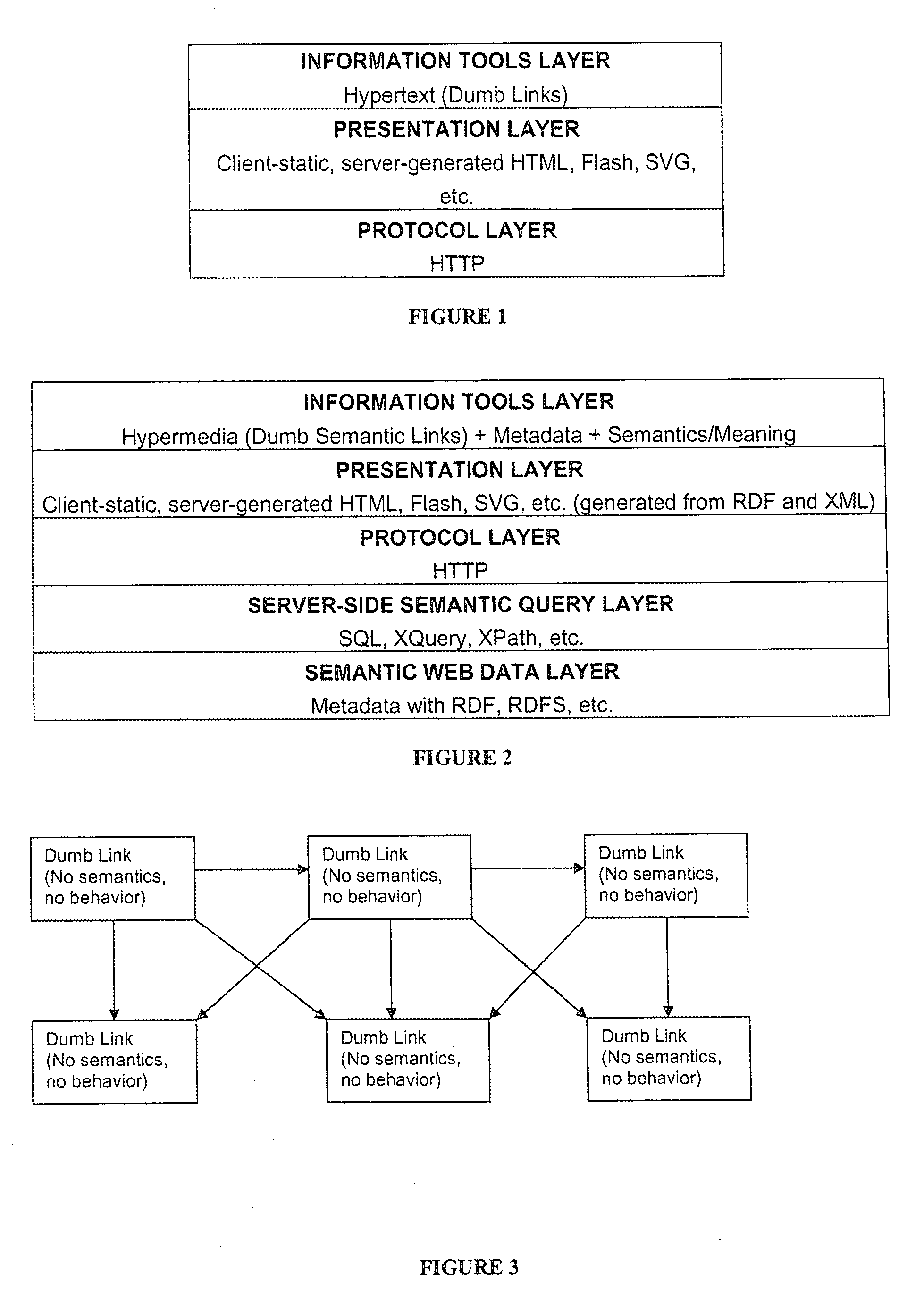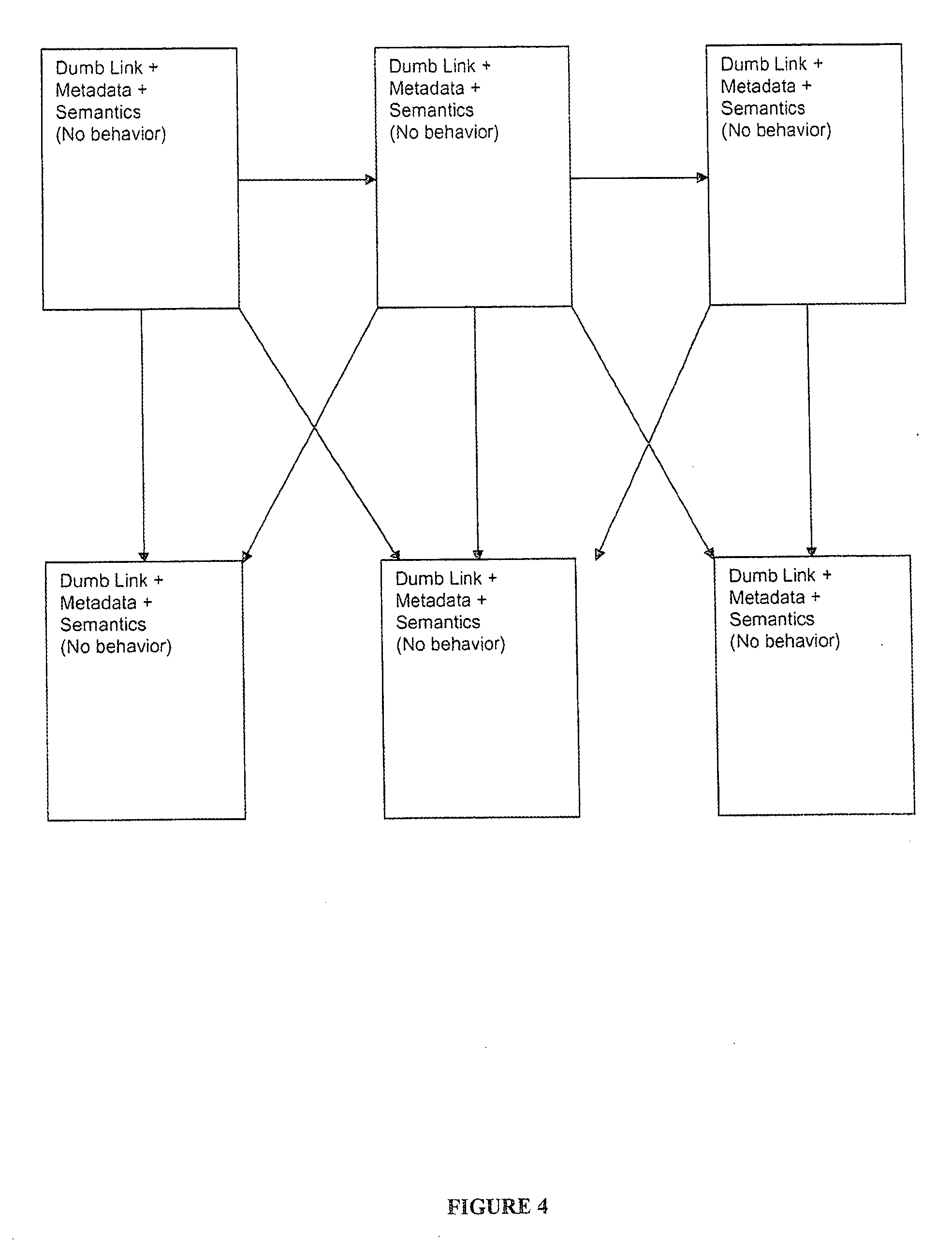The information economy in large part is a struggle to find a way to provide context, meaning and efficient access to this ever increasing body of data and information.
Unfortunately, such searching methods produce thousands of largely unresponsive results; documents as opposed to actionable knowledge.
The result is continued
ambiguity and inefficiency surrounding the use of the Web as a tool for acquiring actionable knowledge.
And there lies the problem.
The Web, in large measure, has fulfilled the dream of “information at your fingertips.” However, knowledge-workers demand “knowledge at your fingertips” as opposed to mere “information at your fingertips.” Unfortunately, today's knowledge-workers use the Web to browse and search for documents-compilations of data and information-rather than actual knowledge relevant to their inquiry.
While conceptually a significant step forward in supporting improved context, meaning and access of information on
the Internet, the
Semantic Web has yet to find successful implementation that lives up to its stated potential.
Both the current Web and the
Semantic Web fail to provide proper context, meaning and efficient access to data and information to allow users to acquire actionable knowledge.
This is partially a problem related to the ways in which Today's Web and the contemplated
Semantic Web are structured or, in other words, related to their technology
layers.
As explained in greater detail below, there are serious limitations associated with each of the technology layer structures.
Such a query is not possible on the Web today.
The lack of
semantics also implies that Today's Web does not allow users to navigate based on they way humans think.
First, it means that the Web is not programmable.
As such, the Web does not employ the enormous
processing power that computers are capable of—because it is not represented in a way that computers can understand.
The lack of
semantics also implies that information is not actionable.
As such, once a user receives search results, he or she is “on his or her own.” Also, a
web browser does not “understand” the information it is displaying and as such cannot do smart things with the information.
Information presented without
semantics is not actionable or might require that the semantics be inferred, which might result in an unpleasant user experience.
Today's Web lacks context-sensitivity.
For example, documents in accessible storage are independently static and therefore stupid.
This results in information and productivity losses.
However, this is still very limiting because knowledge-workers are completely helpless if nothing dynamically and intelligently connects
relevant information in the context of their task with information that users have access to.
Likewise, it is not enough to just notify a user that new data for an entire portal is available and shove it down to their local hard drive.
It lacks a customizable presentation with context sensitive alert notifications.
The Semantic Web suffers from the same limitations as Today's Web when it comes to context-sensitivity.
The Semantic Web, as a standalone entity, will not be able to make these dynamic connections with other information sources.
Today's Web lacks time-sensitivity.
This results in a huge loss in productivity because the Web platform cannot make time-sensitive connections in real-time.
The Semantic Web, like Today's Web, also does not address time-sensitivity.
Today's Web lacks automatic and intelligent discoverability of newly created information.
There is currently no way to know what Web sites started anew today or yesterday.
The same problem exists in enterprises.
On Intranets, knowledge-workers have no way of knowing when new Web sites come up unless informed via some external means.
In addition, there is no context-sensitive discovery to determine new sites or pages within the context of the user's task or current
information space.
The Semantic Web, like Today's Web, does not address the lack of automatic discoverability.
Semantic Web sites suffer from the same problem-users either will have to find out about the existence of new information sources from external sources or through personal discovery when they perform a search.
This has several problems.
If Web pages are not updated or if
Web page or site authors do not have the discipline to add links to their pages based on relevance, the network loses value.
Today's Web is essentially prone to having dead links, old links, etc.
Another problem with a pure network or graph
information model is that the information
consumer is at the mercy of—rather than in control of the presentation of the
Web page or site.
Search engines are of little help because they merely return pages or nodes into the network.
The Semantic Web suffers from the same problem as Today's Web because the Semantic Web is merely Today's Web plus semantics.
In other words, the Semantic Web is also dependent on the discipline of the authors and hence suffers from the same aforementioned problems of Today's Web.
If the Semantic Web includes pages with ontologies and
metadata, but those pages are not well maintained or do not include links to other relevant sources, the user will still be unable to obtain current links and other information.
The Semantic Web, as currently contemplated, will not be a smart, dynamic, self-authoring, self-healing network.
The Semantic Web suffers from a similar problem as Today's Web in that there is no user-controlled browsing.
Another problem with Today's Web is the requirement that only documents that are authored as
HTML can participate in the Web, in addition to the fact that those documents have to contain links.
This is very limiting, especially since there might be
semantic relevance between information objects that are not
HTML and which do not contain links.
Furthermore, search engines do not return results for the entire
universe of information since vast amount of content available on the web is inaccessible to standard web crawlers.
Today's Web servers do not provide
web crawler tools that address this problem.
The Semantic Web also suffers from this limitation.
It does not address the millions of non-
HTML documents that are already out there, especially those on users” hard drives.
The implication is that documents that do not have
RDF metadata equivalents or proxies cannot be dynamically linked to the network.
Today's Web does not allow users to customize or “
skin” a
Web site or page.
The Semantic Web does not address the issue of flexible presentation.
Essentially, the Semantic Web does not provide for specific user empowerment for presentation.
As such, a Semantic
Web site, viewed by Today's Web platform, will still not empower the user with flexible presentation.
Because Today's Web does not have any semantics,
metadata, or knowledge representation, computers cannot process Web pages using logic and
inference to infer new links, issue notifications, etc.
As such, Today's Web cannot operate on the information fabric without resorting to brittle, unreliable techniques such as screen scraping to try to extract metadata and apply logic and
inference.
While the Semantic Web conceptually uses metadata and meaning to provide Web pages and sites with encoded information that can be processed by computers, there is no current implementation that is able to successfully achieve this
computer processing and which illustrates new or improved scenarios that benefit the information
consumer or producer.
Today's Web does not allow users to display different “views” of the links, using different filters and conditions.
For example, Web search engines do not allow users to test the results of searches under different scenarios.
These queries lack flexibility.
Today's Web does not allow a user to issue queries that approximate
natural language or incorporate semantics and local context.
For example, a query such as “Find me all email messages written by my boss or anyone in research and which relate to this specification on my hard disk” is not possible with Today's Web.
For example, users will be able to issue a query such as “Find me all email messages written by my boss or anyone in research.” However, users will not be able to incorporate local context.
In addition, the Semantic Web does not define an easy manner with which users will query the Web without using
natural language.
Natural language technology is an option but is far from being a reliable technology.
For example, if users encounter a dead link (e.g., via the “404” error), they cannot “fix” the link by pointing it to an updated target that might be known to the user.
This can be limiting, especially in cases where users might have important knowledge to be shared with others and where users might want to have input as to how the network should be represented and evolve.
While the Semantic Web conceptually allows for read / write scenarios as provided by independent participating applications, there is no current implementation that provides this ability.
And while some specific Web sites support annotations, they do so in a very restricted and self-contained way.
Today's Web medium itself does not address annotations.
In other words, it is not possible for users to annotate any link with their comments or additional information that they have access to.
While the Semantic Web conceptually allows for annotations to be built into the system subject to security constraints, there is no current implementation that provides this ability.
On Today's Web, this lack of trust also means that Web services remain independent islands that must implement a proprietary user subscription
authorization,
access control or
payment system.
Grand schemes for centralizing this information on 3rd party servers meet with
consumer and vendor distrust because of privacy concerns.
While the Semantic Web conceptually allows for a Web of Trust, there is no current implementation that provides for this ability.
Neither Today's Web nor the Semantic Web allows users to independently create and map to specific and familiar semantic models for
information access and retrieval.
 Login to View More
Login to View More  Login to View More
Login to View More 


